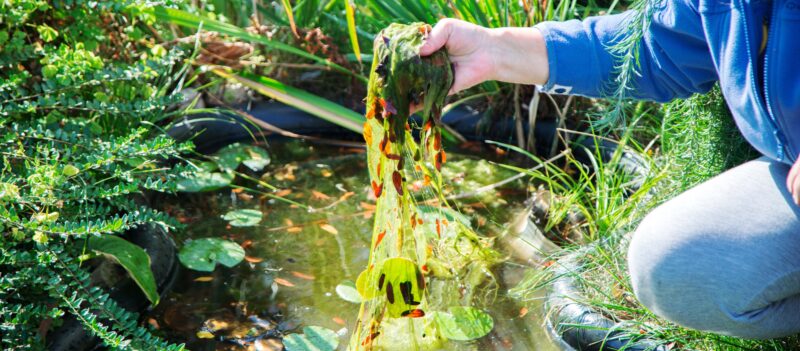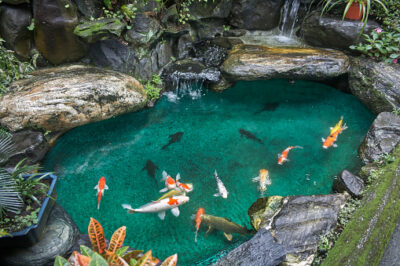You can harm your aquatic life and deplete oxygen from your backyard pond if you have too many string algae growing. Water with weird colors may be unclean, but green water does not necessarily mean the pond is unhealthy. It is important to test Water parameters to determine how far the water has cycled before choosing an appropriate solution.
Identifying string algae in your pond is the first step to mastering string algae. String algae can clump and tangle together to form mats that look like blankets. Examine the mats to determine whether there are many individual strings inside.
String algae: What is it and is it dangerous?
In aquatic environments, string algae attach themselves to plants, hang from rocks in waterfalls, or float on the surface of the water (also known as blanket algae).
Algae that form strings are filamentous (stringy filament) plants, and they tend to grow off the sides of rocks or cover the water’s surface. Because string algae can grow rapidly in size and length, it is best to control it quickly from the moment it is you spot it in your pond.
An unsightly green mess that adheres to rocks is not the same as the soft, velvety, jelly-like algae on the pond’s sides. Although string algae may appear ugly, they pose no major threat to your fish’s health, but they can significantly affect your pond’s appearance.
While string algae do not pose a serious threat to the health of inhabitants, the algae negatively affect the quality of water and the appearance of ponds.
When not handled properly, however, it can cause harm.
It is not a one-day task to solve string algae problems. String algae problems can produce regaining balance in as little as one week to as long as three months, depending on severity.
String algae is a result of excessive nutrients – to stop the growth cycle, you need to reduce the nutrients.
There is no absolute correlation between excessive string algae and poor water quality, but it will reduce oxygen content. The reason is that it indicates that the water has beneficial qualities. In general, algae that extend longer than 3′′ is harmful, but anything containing carpet algae, which contain micro-organisms that promote a healthy water column, is acceptable.
In contrast, blue-green algae can be more dangerous for your pond. Check out our article on what to watch for.
Pond String Algae: How to Remove It
String algae can be removed and reduced by scooping it out first and addressing the underlying problem in your water chemistry if it returns.
Your waterfall will prove to be the most challenging part of your pond to clean. Water treatments find it difficult to do their jobs effectively since the water rushes by so quickly. It may take up to two seasons for your waterfall to be completely free of string algae, so be patient and ensure that you are not adding extra nutrients, which could fuel more algae growth.
Aerators are very important to your pond. Learn why you should choose the right one.
The 5 Steps to Removing & Reducing Algae
Step 1. Physically Remove String Algae –
If you want to remove string algae, this is your best option. Despite it being dirty, it is a critical step in reducing the amount of decay before treating it.
In order to begin the recovery process, this first step must be taken, no matter what you do.
The easiest way to get leverage and pull the algae from its root is to wrap the root end around your hand or finger and pull it out. If the algae are at any depth or as long as a broomstick or pole, you may have to wrap the algae around an elongated tool like one.
The biggest pieces should be pulled from the base, pulled hard, and put in the bucket. Algae is usually soft and malleable, making it hard to remove a lot at once. Physical removal is the quickest way to clear pond water and get rid of algae. A toilet or long lint brush are other options besides winding around fingers or hands.
Due to the thin strands, it is challenging to remove the bristles of a brush by hand. The wearing of gloves is optional but may make you more hygienic. You can remove the algae at depth using a brush with a long handle.
Step 2. Treat Water and Kill Off Remaining Algae –
While pond algaecide can be used to kill some remaining string algae, we reject any unnatural chemicals no matter how safe they claim to be. On pond walls and some rocks, hair-like or blanket-like algae is completely acceptable and should be left alone.
The most common causes of string algae are high pH and Phosphorous (P) levels. If you find that you have high pH or high Phosphorous levels in your pond water, you may adjust it based on the following measures.
Bringing Your pH Levels Down
- Besides string algae, clear algae blooms are occurring
- Overgrown plants should be removed or tripped
- Change the pond where the fish are kept
- Experiment with removing potentially contributing rocks (calcium, limestone)
Low Phosphorus Levels and the Effects
- Make sure fertilizer is not coming from run-off (or from direct application) if you see it in your pond.
- Algae blooms should be removed whenever possible
- Cleaning out grass clippings from your pond is recommended if you have them
- Plants that consume phosphorus like Anacharis are an excellent solution.
Changing the pH and phosphorus levels can help reduce the growth of algae, but further measures must be taken to stop the growth. To master your algae problem, you must do this.
Step 3. Add Extra Plants and Remove Decay –
Increase the oxygen content of your pond by adding plants that grow rapidly and reproduce. Ensure you remove decaying plants before fighting algae, as they will not help. Pick plants that will grow larger and consume a lot of nutrients, along with requiring little to no maintenance. To provide extra oxygen to your pond and to attract pests that consume string algae, you will want to add plants. The key is to bring in plants that are capable of consuming large amounts of nutrients.
During warmer months, securing Ice crops, Water lettuces, and Cattails will help you prevent algae blooms. Winter months are ideal for planting Water Hawthornes
String algae will be unable to reproduce due to the plants out-competing them for nutrients. Not to mention, adding lush plants to your pond will never hurt
This plant sprouts early in the spring and helps get your pond ready for the weather. In winter, Water Hawthorne is a great plant. It does best in the cold months and is more expensive in the summer.
Your pond will grow new vegetation if you remove some extra plants every now and then.
Spectacular plants that compete with algae and suspend excess nutrients can solve many problems for pond owners. You’ll want to avoid putting in plants that have algae already growing on them!
Step 4. Find the Cause of the Algae Growth –
By testing your water quality, you can find out what could be causing string algae. Algae growth at a problematic level means it is time to dig deeper into the pond’s chemistry instead of just looking at the algae and mat. Phosphorous levels and high pH levels are the primary causes of algae blooms.
In addition to clearing algae blooms and excessive plant growth, overstocking fish and untreated concrete, foreign materials (stones containing calcium and granite) can cause high pH levels. Fertilizers that have leaked into the pond water are the most common cause of high phosphorus levels. The iron that is deposited in the pond as well as grass clippings is another major contributor. Remove green grass blades as soon as possible.
Step 5. Feed Koi & Fish Less to Reduce Excess Nutrients –
In fish ponds, owners make the common mistake of overfeeding their fish, thus adding too much nutrient to the water. Unconsumed food in the pond indicates that you have fed the fish too much. Fish that are fed less will also be more likely to consume other substances in a pond. As if algae were alive! You will be surprised how quickly your fish can cut through string algae if you feed them less this summer.
Keeping excess nutrients under control can be accomplished easily with a few corbicula clams in the pond. Approximately one liter and a half of water is filtered by one clam an hour.
The most common problem pond owners face is overfeeding the fish, often at their own expense. Overfed fish not only release ammonia and other harmful chemicals, but overeating will also leave little room in the pond for other substances. That’s right, just like algae! When you overfeed, you should observe whether food remains in the pond after feeding. You want your fish to be hungry and full at the same time so that they can stay healthy.
Your life will be much easier if you add corbicula clams to your environment. The claim is that the filter filters 1.5 liters of water an hour for nutrients!
Is it possible to use an algaecide to control pond algae?
The most common method for controlling algae is to add a copper-based algaecide to kill visible string algae. Although algaecide may be useful occasionally, you should apply it with caution. It may have toxic effects on fish, plants, and wildlife if you overuse and/or kill algae too quickly. Overusing and/or killing algae can lead to oxygen depletion.
The “good” bacteria designed to keep a pond clean are also negatively affected by algaecides. In the absence of these, algae will grow more readily, forcing a pond owner into a never-ending cycle of chemical treatments. However, algaecides only control what you can see; they do not address the larger issue.
Excess organic matter can also be produced by killing the algae. This will cause the algae problem to return repeatedly. You’ll notice your fish are happier, more colorful, and active when you use Nualgi Ponds as an algaecide substitute.
How much barley straw should I use?
It is an excellent organic product to use, but it does little to kill existing algae and create a condition that prevents new algae from growing. You should plant this early in the season to avoid a possible algae bloom. As the straw decays, it may lead to fish kills if too much barley straw is added to the pond.
The recommended dosage is 2 lbs per 1000 gal of water. Straw should be used at a dosage of 50 grams (2oz.) per square meter of water surface area instill and small ponds.
For the straw to begin producing the active chemicals that reduce algae in cold water (less than 50°F), it may take six to eight weeks. When the temperature of the water is above 70F, it becomes effective within two weeks. The effects of barley straw last appreciably longer after they are applied. Straws must be removed and replaced when they begin to smell. It is an indication that there is too much straw and not enough water.
Pond Algae Removal – Enlisting Help
It is time to get creative if the thought of manually scooping out algae disgusts you. Please consider writing a story about pond algae control for your children/grandchildren. Alternatively, enlist the help of a neighbor to scoop up the scum. Ensure that everyone is aware of the safety precautions around the pond.
Keep an eye on water quality parameters and remove string algae manually. After you remove the string algae from your water, if the problematic algae persist, it could be a sign of a deeper problem within your water that needs further investigation. Taking a deep breath, adding some plants, and implementing a natural water treatment is vital.










